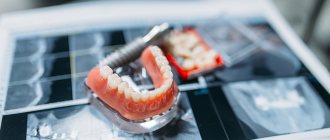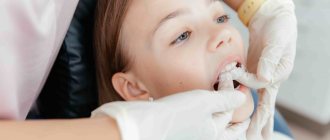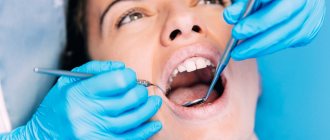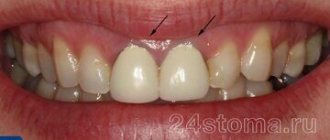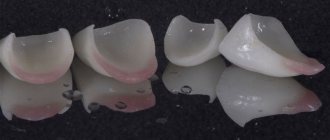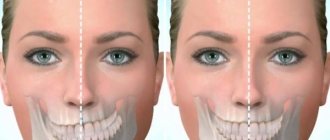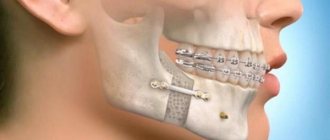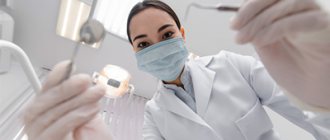Publication date: March 13, 2022.
Information on this page was updated on December 31, 2021.
TMJ dysfunction is a fairly common pathology these days, as it is largely caused by stress factors. Here it can be difficult to understand what is primary and what is secondary, because people with joint dysfunction usually come with bite pathology, pathology of the musculoskeletal system (curvature of the spine, neck). Therefore, joint treatment is a complex story. It happens that the primary pathology is a pathology of the joint, and sometimes it is the musculoskeletal system.
Comprehensive treatment of TMJ
When the doctor has determined the cause of the joint pathology, or causes, he determines the patient's readiness for a comprehensive treatment plan. In addition to the orthodontist, an osteopath or chiropractor may be involved, or even an orthopedist if more complex correction of the musculoskeletal system is required.
The patient should be aware that it is possible to straighten the jaw using a splint or splint, but this will not solve the problem of malocclusion. Orthodontic treatment will be required to correct the bite. If you have already had orthodontic treatment before, then it is more difficult to decide on repeated treatment.
Therefore, first the problem with the joint is solved using a splint or joint splint, then bite correction is carried out, and, if necessary, prosthetics. In parallel, work is underway with an osteopath to restore the muscular corset of the back and neck.
It happens that a patient refuses treatment with braces after the problem with the joint has been resolved. In this case, we warn him about the need to wear a joint splint constantly in order to avoid the recurrence of old problems with the TMJ. After all, a relapse can happen quite quickly due to stress.
Table: how to figure out who to contact
| What's troubling? | Which dentist should I contact? |
| Bleeding gums/Teeth sensitivity | Hygienist or periodontist |
| Missing teeth | Orthopedist |
| Have crooked teeth/bad bite | Orthodontist |
| Tooth hurts / The wall has broken off / There is caries | Therapist |
| The wisdom tooth is painfully erupting / Swelling has appeared on the side of the cheek | Surgeon |
All dentists conduct an examination, consultation, draw up a treatment plan and perform a thorough diagnosis of the entire oral cavity. In modern dentistry, an integrated approach to each clinical situation is valued, taking into account all the individual characteristics of the patient’s body.
What may be the symptoms of TMJ dysfunction?
- Tenderness or pain in the area of one or both TMJs at rest or when opening the mouth.
- Crunching, clicking, crepitation and other noises in the area of one or both TMJs when opening the mouth.
- History of TMJ injuries (previous), incl. dislocation, subluxation, chronic subluxation.
- Restrictions in the mobility of the TMJ, restrictions in opening the mouth.
- Excessive tone of the masticatory muscles, bruxism (“grinding” of teeth in sleep, at rest).
- Asymmetry of the chin, lips, lip frenulum, asymmetry of mouth opening, S-shaped opening.
- Suspicion of a forced position of the lower jaw.
Structure of the TMJ
The presence of one or more of the above symptoms may indicate TMJ dysfunction.
Traditional orthodontic treatment does not address TMJ dysfunction. During orthodontic treatment, the severity of dysfunction may not change, decrease or increase. At the moment, in the world scientific orthodontic literature there is no convincing data on the connection between orthodontic treatment and the condition of TMJ. Deterioration of the joint after treatment may have nothing to do with this treatment.
Note! Even in the absence of visible clinical manifestations of joint dysfunction, hidden disorders may occur that require special diagnostics to identify them.
If there is a forced incorrect position of the lower jaw, its position may change during the treatment process with changes and complication of the treatment plan (the need to remove individual teeth, increasing the duration of treatment). A reliably forced position cannot be diagnosed by traditional orthodontic methods; to verify its presence, as a rule, a special analysis is required (manual functional analysis, determination of the central relationship of the jaws), the use of a special articular splint for a period of several months, which, however, does not give 100 % guarantees.
To conduct a detailed articular diagnosis, explain the specifics of your case, and further manufacture an articular splint, you can make an appointment with an orthodontist who deals with the issue of TMJ dysfunction.
TMJ dysfunction is a chronic condition that can be compensated, but not cured (i.e., it is possible to eliminate symptoms, however, pathological changes in the joints, if they have already occurred, will most likely persist).
Dental hygienist
A dental hygienist has a secondary professional medical education. A prerequisite for working as a hygienist is to successfully complete the course “Preventive Dentistry”. What does a dental hygienist do:
- professional oral hygiene;
- treatment of gums with the Vector device;
- whitening;
- provides training in proper oral hygiene;
- selection of personal hygiene products;
- deals with the prevention of gum disease in adults and children.
In short, the main area of work of a dental hygienist is the removal of dental plaque (tartar, plaque). It is important to see a hygienist every six months to maintain oral health.
What happens if TMJ dysfunction is not treated?
If the dysfunction is not treated, the compensatory capabilities of the body may sooner or later be exhausted, the symptoms will worsen, the pathology will begin to progress, causing greater discomfort (sometimes for several years), thereby affecting the deterioration of the function of the dental system.
In order to try to prevent this and carry out treatment taking into account the individual characteristics of the structure and functioning of the temporomandibular joints, patients are usually offered the following approach.
Dentist-therapist
The main field of activity of this doctor: treatment and prevention of caries and its complications. What manipulations does:
- treatment of caries;
- endodontics (work in root canals) for pulpitis, periodontitis;
- root canal retreatment;
- chipped fillings, tooth walls;
- carrying out treatment using a microscope (treatment of caries, work in canals);
- providing assistance for acute toothache.
The therapist also conducts a thorough examination and can refer the patient to related specialists if he notices any pathology.
Treatment method for TMJ dysfunction
1. Diagnosis of TMJ dysfunction.
- When diagnosing a joint in the clinic, a series of measurements and tests are carried out, all sensations in the joint area are recorded (discomfort, clicks, pain, deviation of the jaw when opening and closing), the difference in sensations in the right and left joint.
- The orthodontist also takes impressions of the jaws and takes photographs of the face and intraoral photographs, and also performs three-dimensional computed tomography of the face (3D CT); if necessary, the doctor can give a referral for an additional study - magnetic resonance imaging of the TMJ (MRI).
- Often, the orthodontist, in addition to manual functional analysis, conducts a visual assessment of: posture, symmetry of the shoulder girdle, shoulder blades, hip bone structures, etc., performs the necessary tests and photographs. Based on the results, it is possible to schedule a consultation with an osteopath or chiropractor to jointly manage the patient. Related specialists (orthopedist, surgeon, periodontist) can also be involved in drawing up a treatment plan.
What exercises are prescribed to patients to normalize the work and relax the masticatory muscles?
Exercise No. 1
Draw a vertical line on the mirror with a marker, stand opposite so that the line divides your face into the right and left halves, place your fingers on the area of the articular heads, lift your tongue up and back, open and close your mouth along the line (it may not work right away), 2-3 times /day 30 repetitions. There is no need to open your mouth wide (a comfortable width), the main thing is symmetrically (so that the jaw does not “move” in any direction). If there is a click, open until it clicks.
Exercise No. 2 (cycle)
Do it whenever possible, for example, in front of the TV, at the computer, or in a traffic jam while driving. Open and close your mouth without closing your teeth for 30 seconds, then alternately reach your right and left cheeks with your tongue for 30 seconds. Open - close your mouth again, then for 30 seconds move your tongue in a circle inside the vestibule (behind the lips), first in one direction, then in the other direction (clockwise - counterclockwise), open again - close your mouth, etc.. For this a half-hour cycle, the teeth should not touch, the lips should be closed. If you want to close your mouth or swallow, place your tongue between your teeth. Repeat the cycle for 20-30 minutes 2-3 times/day
Diagnostics
Diagnosing TMJ disorders first involves taking a medical history, followed by a physical examination. The doctor applies light pressure on the side of the face where there is discomfort, on the masticatory muscle fibers. At the same time, the patient closes and opens his mouth. Popping or clicking sounds and jaw thrusting are analyzed. If indicated, an MRI may be prescribed. The procedure will show whether there are internal problems with the joint. If osteoarthritis is suspected, x-rays and CT scans can confirm the diagnosis.
Pain in the jaw joint when chewing and opening the mouth often occurs with infectious arthritis. Diagnosis is made by inserting a needle into the joint itself to collect fluid. This research method is called aspiration. The liquid is analyzed for the presence of pathogenic bacteria. Hypermobility and ankylosis are determined by the width of the mouth opening. Sometimes the patient is referred for polysomnography to determine sleep disorders. An orthopantomogram of the jaw plays an important role in the research process.
Occlusive therapy for TMJ dysfunction
After diagnosis, the patient is scheduled for an appointment with the orthodontist to determine the central relationship of the jaws (“true” position of the lower jaw, the position in which your joint and chewing muscles will be most comfortable).
In order to more accurately establish and fix this position, an occlusal splint (splint) will be individually made for the patient from a special plastic, which is erased as it is worn. The splint must be worn constantly (sleeping, talking, eating in it if possible) - this is the meaning of occlusion therapy, which will help the joint and masticatory muscles rebuild into the most comfortable functional state.
Cleaning and caring for the splint is very simple - after eating (as well as while brushing your teeth), brush with a soft brush with toothpaste or soap.
Orthopedic dentist
Dental services include dental prosthetics. It is the orthopedic dentist who deals with all types of dental restoration using orthopedic structures. These include:
- crowns;
- bridges;
- veneers, lumineers;
- inlays, overlays;
- mouthguards, splints;
- temporary structures for long-term orthopedic treatment;
- removable and fixed dentures;
- prosthetics on implants.
Installation of a brace system for a patient with TMJ dysfunction
Installation of a brace system on the upper jaw is carried out on average after 3 months of occlusion therapy. The splint is adjusted once every 1-2 weeks, or at the discretion of the doctor, until the main complaints from the TMJ are eliminated (in parallel with the alignment of the teeth in the upper jaw), then a brace system is installed on the lower jaw with partial reduction (grinding) of the interfering parts of the occlusal tires, or complete removal. Here the patient needs to be patient - the process may take several months.
At the same time, the new position of the lower jaw is monitored: repeated manual functional analysis, photometry, bite registration is possible, computed tomography of the face during treatment, continuation of orthodontic treatment with a brace system.
Upon completion of orthodontic treatment, final monitoring of the position of the lower jaw follows (manual functional analysis, photometry, bite registration, 3D CT scan of the face upon completion (after) treatment).
Joint splint
Joint splint with braces
Pediatric dentist
Treatment and extraction of teeth for patients under 18 years of age is carried out by a pediatric dentist. When working with young patients, the primary task is to find contact with the child and get him ready for treatment, because almost all children enter any medical office with fear. In addition, the children's doctor needs to tell the child's parents how to carry out home oral hygiene for the baby, what products to use, when the physiological change of teeth occurs, etc.
Maintaining dental health from a very early age is necessary for the normal formation of the dental system.
Why does your jaw crunch and what to do?
What to do if your jaw cracks?
Problems of the dental area are not limited to caries or inflammation, malocclusion or deviations,
associated with short bridles.
Temporomandibular joint dysfunction (TMJ) is another type of disorder. This paired organ carries out its activity more often than others, participating in all mobile processes, yawning, chewing, and sound reproduction. It is not surprising that with such activity of the joint, certain manifestations of imbalance in its work are not something exceptional; in one form or another they occur in many people. Problems with the functioning of the lower jaw complicate not only the chewing process. The condition of this area is very important for a person’s overall well-being. Difficulties with nutrition lead to disruption of the functioning of other organs and systems of the body, and contribute to psychological stress. If you notice at least one of the questionable signs, contact a specialist dentist-gnathologist. Solving a medical problem at an early stage always ensures a more successful result and a speedy recovery.
During the consultation, the specialist will conduct an examination, functional tests, and prescribe further diagnostic tests. The results obtained will become the basis for drawing up an individual treatment plan.
Clinical symptoms indicating a dysfunction of the TMJ.
The very first sign that people pay attention to when there are problems with the functioning of the temporomandibular joint is noise. Patients describe it as a crunching, grinding, clicking sound in the jaw when opening the mouth. The resulting popping sound represents the displacement and return to normal position of the disc located between the fossa of the temporal bone and the head of the mandible.
Many people get used to this sound, consider it a variant of the norm, and stop
pay attention.
However, such indifference to the problem lasts until pain joins the clicking, or other pathological signs are detected. We are talking about the development of such symptoms:
- Pain in the ear when opening the mouth;
- Shift of the jaw to the side relative to the median position.
- Pinching of the jaw when opening the mouth, its jamming.
- The appearance of pain in the jaw after increased exercise, the end of a long meal or a long speech.
- Signs of emerging changes in bite (underbite) as a result of pathological abrasion.
- Teeth grinding, both during the day and at night (bruxism).
- Headache, dizziness, pain and pressure in the ears.
The main causes of symptoms in the form of clicking in the joint.
Clicking in the mandibular joint is just one of the symptoms of damage to the temporomandibular joint. The specialist’s task is to clarify other nuances of the manifestation of pathological signs, identify the cause of their development, and then develop treatment tactics. If your jaw is crunching, you already know which doctor you should see. It is the dentist-gnathologist who will be able to provide effective assistance in this matter, clearly determine the nature of the existing symptoms, conduct a diagnosis and prescribe treatment. The main reasons for the development of pathological signs associated with joint damage:
- Dislocation of the TMJ, other types of traumatic lesions, bruises, cracks,
fractures of the jaw bones. - Bruxism, excessive tension or spasm caused by increased nervousness and stress.
- Malocclusion.
- Periodontitis and tooth mobility.
- Pathological abrasion
. - Poor quality work by the dentist, incorrect placement of the filling.
- Incorrect prosthetics with bridges and crowns.
- Absence of teeth for a long time, which leads to load shifting.
- Using incorrectly made dentures.
- Bad habits like chewing only on one side.
If your jaw crunches when chewing and you don’t know which doctor to see, use. Our specialists, relying on a whole range of modern research, will be able not only to make the correct diagnosis, but also to prescribe effective treatment. Depending on the nature of the lesion and the severity of symptoms, treatment for clicking in the jaw when opening the mouth can be either conservative or surgical.
Conservative treatment.
Treatment prescribed by a gnathologist is usually comprehensive and is aimed at different parts of the pathological process. It will be especially effective in cases where it is possible to identify the causes of operational failures.
- If joint damage is the result of poorly installed
orthopedic design, then to improve the situation it is necessary to undergo repeated prosthetics. - The same should be done in the case of an incorrectly installed seal, up to and including re-sealing.
- To improve the closure of the dentition, it is possible to grind off the hard tissues of the teeth that prevent this.
- If the imbalance in the joint is due to orthodontic problems, orthodontic treatment will be required.
- If there is a change in the height of the bite (decrease) due to pathological abrasion and bruxism, various types of splints (splints) are used.
If conservative methods are ineffective, in difficult situations they resort to surgical intervention.
Surgery.
In complex cases of bone ankylosis, only surgical intervention is indicated, which consists of restoring the functions of the joint by eliminating bone deformities.
The surgeon performs an osteotomy of the mandibular ramus and subsequent arthroplasty of the temporomandibular joint. The resulting defect is replaced with a bone autograft.
After completion of such an operation, to maintain surgical correction for an extended period of time, from several months to several years, exercises aimed at ensuring correct movements of the lower jaw will be required. The scale of the actions taken is evidenced by the fact that in the future patients are forced to resort to mentoplasty - surgery to eliminate defects in the chin and face shape.
The services of a surgeon may also be required if the head of the mandible is dislocated. The essence of the procedure is that the specialist returns it to the joint capsule and applies a fixing bandage to the lower jaw for several days. A gentle diet will also help to create rest for the organ and speedy rehabilitation. To limit yourself to such treatment tactics, the patient should see a doctor as quickly as possible after the injury. Old dislocations will be more difficult to correct. In these cases, surgery to reconstruct the joint may be required.
Cost of treatment at a gnathologist dentist.
The cost of services for a gnathologist dentist in Moscow varies widely, including
is largely determined by the financial policy of the center. However, high prices do not always reflect the professional level of the doctor or the diagnostic capabilities of the clinic, and the choice of treatment tactics and the success of all dental care often depend on the quality and reliability of the research performed.
To exclude unsatisfactory results of the prescribed procedures, contact the Dentist clinic. In this case, you can reliably count on the highly qualified services of a gnathologist dentist who has extensive experience in this area. In our center it will be possible to carry out a complete diagnosis of the temporomandibular joint using modern techniques, as well as go through all stages of treatment.
Additional motivation will be a lot of positive reviews about the activities of the clinic’s specialists and a free consultation.
